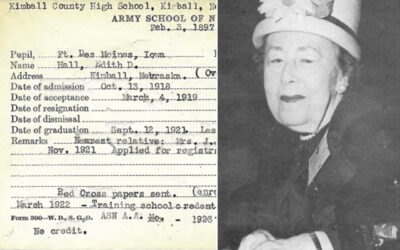
By Matt Skoufalos
Anyone who’s ever understood the wisdom of “home is where the heart is” would be hard-pressed to find someone who’s lived the truth of that expression as fully as Lisa VanDeer, RN, CNOR. Training for her career and doing the job itself in her hometown of Webster City, Iowa, has given this 14-year nurse a sense of familiarity with the community and its inhabitants that helps her to connect deeply with her work.
Working as a nurse “is what I’ve always wanted to do,” VanDeer said.
“I can remember being younger and thinking, ‘When I’m done with high school, I’m going to nursing school,’” she said. “I love taking care of people. They usually go home happy.”
After high school, VanDeer completed her nursing certification at Iowa Central Community College in Webster City, and then was hired on at a 25-bed community hospital, Van Diest Medical Center, just two minutes away.
“One of the reasons I stay is it’s right in my hometown,” VanDeer said. “It’s where I have lived my whole life. I like being able to look at the patient list and see who’s there; it’s comforting for them to be able to see a friendly face.”
“It’s the right fit because it’s a smaller place,” she said. “I wouldn’t want to work in a big hospital where you’re just another employee to some people. It’s very homey and family-friendly.”
That same family atmosphere permeates the surgical department at Van Diest, where Surgery Manager Robin Meyer encouraged members of the nursing staff to earn their Certified Perioperative Nurse (CNOR) credentials, and then supported them through the studying and testing process required to achieve them. The boost to her education (and career) confirmed for VanDeer that she was in the right place with the right people; an environment in which she’s thrived throughout her nursing career.
“Since I’ve been here so long, I do a lot of orientation with new employees, whether it’s the computer system, or how to circulate, or ordering supplies and making sure they have the right stuff for the cases,” VanDeer said. “That’s the kind of leadership I like to do; that’s fun for me and that’s important for me.”
VanDeer also loves working in surgery, where she also oversees sterile processing of equipment, “and there’s little change in the routine,” she said – at least, there was, until this spring, when the novel coronavirus (COVID-19) pandemic swept across the globe.
“I take care of instruments for the clinic, the ER, our department and our satellite clinics,” VanDeer said. “I had all of my normal stuff to do besides doing the pain injections and equipment processing.”
“Now I’ve got something different every day,” she said. “It keeps it interesting.”
When the pandemic hit Iowa in March, health care workers had known it was coming, but were still surprised by how hard it hit. As happened in many parts of the country, surgical departments at Van Diest were limited to taking on emergency cases only. Staffers were offered options of furloughs or unemployment; if nurses wanted hours, they were allowed to work the med/surg floor, but had less say over their schedules. The Monday-through-Friday day shift pivoted to a 24-hour operation, which reflected a considerable change. VanDeer’s unit also received overflow calls from the hospital’s affiliated specialty clinics, which were completely shut down; in short, VanDeer and Meyer found themselves doing the work of a seven-person staff.
Meyer remembers VanDeer as being “by my side the entire time we were heavy in COVID-19.”
“It was really hard to come to work every day,” Meyer said. “It was going to be me and Lisa, and that was all it was going to be, no matter what they threw at us. Lisa came to work every day with a smile on her face, and kept all of the instrumentation in the hospital cleaned and sterilized.”
That latter contribution was especially important, as sterile equipment was in short supply during the pandemic. Given a global dearth of N95 masks, VanDeer worked out a way to reprocess them using the Sterrad plasma sterilization unit in her department and an FDA-certified cleaning plan. Thanks to her efforts, health care workers in her department and the affiliated clinics could get three uses out of a single face covering – once out of the package and twice more after reprocessing – which helped them get through the worst of the shortage in personal protective equipment (PPE).
By mid-June, normal operations ramped up slowly; employees started to return, and eventually, new patients were scheduled again. Educating them about safety measures in the facility did take some doing as well as an abundance of caution. Neighboring counties have had quite a few COVID-19 cases, in part due to seasonal workers in Iowa’s heavy agrarian communities, and in part because of refusals to wear protective face coverings in a state without a mandatory mask law. Hamilton County, where Webster City is located, has only seen about 400 COVID-19 cases, but Story and Webster counties’ cases number in the thousands.
For many patients, it was a surprise that they had to wear face coverings on the hospital premises. Thankfully, and in no small part because of tight, in-house controls, as well as to Meyer’s and VanDeer’s efforts, the hospital hasn’t faced any significant COVID-19 outbreaks during its return to normal operations. For VanDeer, it’s part and parcel of a career that is implicitly “a continuous, everyday learning process.”
“A couple years ago, did I ever think I would be in charge of all the sterile processing?” VanDeer said. “No, but I’ve been doing that for a year, and I love it. Every day is a little different for me. I still get to scrub for surgeries; I still get to circulate. In our department, I get to do it all. It’s a win-win for me.”










